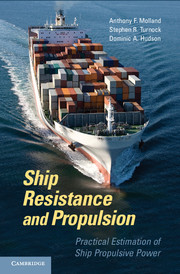Book contents
- Frontmatter
- Contents
- Preface
- Nomenclature
- Abbreviations
- Figure Acknowledgements
- 1 Introduction
- 2 Propulsive Power
- 3 Components of Hull Resistance
- 4 Model-Ship Extrapolation
- 5 Model-Ship Correlation
- 6 Restricted Water Depth and Breadth
- 7 Measurement of Resistance Components
- 8 Wake and Thrust Deduction
- 9 Numerical Estimation of Ship Resistance
- 10 Resistance Design Data
- 11 Propulsor Types
- 12 Propeller Characteristics
- 13 Powering Process
- 14 Hull Form Design
- 15 Numerical Methods for Propeller Analysis
- 16 Propulsor Design Data
- 17 Applications
- Appendix A1 Background Physics
- Appendix A2 Derivation of Eggers Formula for Wave Resistance
- Appendix A3 Tabulations of Resistance Design Data
- Appendix A4 Tabulations of Propulsor Design Data
- Index
- References
15 - Numerical Methods for Propeller Analysis
Published online by Cambridge University Press: 07 September 2011
- Frontmatter
- Contents
- Preface
- Nomenclature
- Abbreviations
- Figure Acknowledgements
- 1 Introduction
- 2 Propulsive Power
- 3 Components of Hull Resistance
- 4 Model-Ship Extrapolation
- 5 Model-Ship Correlation
- 6 Restricted Water Depth and Breadth
- 7 Measurement of Resistance Components
- 8 Wake and Thrust Deduction
- 9 Numerical Estimation of Ship Resistance
- 10 Resistance Design Data
- 11 Propulsor Types
- 12 Propeller Characteristics
- 13 Powering Process
- 14 Hull Form Design
- 15 Numerical Methods for Propeller Analysis
- 16 Propulsor Design Data
- 17 Applications
- Appendix A1 Background Physics
- Appendix A2 Derivation of Eggers Formula for Wave Resistance
- Appendix A3 Tabulations of Resistance Design Data
- Appendix A4 Tabulations of Propulsor Design Data
- Index
- References
Summary
Introduction
Ship powering relies on a reliable estimate of the relationship between the shaft torque applied and the net thrust generated by a propulsor acting in the presence of a hull. The propeller provides the main means for ship propulsion. This chapter considers numerical methods for propeller analysis and the hierarchy of the possible methods from the elementary through to those that apply the most recent computational fluid dynamics techniques. It concentrates on the blade element momentum approach as the method best suited to gaining an understanding of the physical performance of propeller action. Further sections examine the influence of oblique flow and tangential wake, the design of wake-adapted propellers and finally the assessment of cavitation risk and effects.
Although other propulsors can be used, Chapter 11, the methods of determining their performance have many similarities to those applied to the conventional ship propeller and so will not be explicitly covered. The main details of the computational fluid dynamic (CFD) based approaches are covered in Chapter 9 as are the methods whereby coupled self-propulsion calculations can be applied, Section 9.6.
Information
- Type
- Chapter
- Information
- Ship Resistance and PropulsionPractical Estimation of Propulsive Power, pp. 337 - 368Publisher: Cambridge University PressFirst published in: 2011
